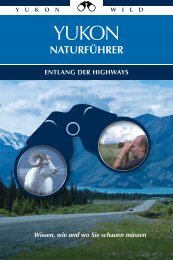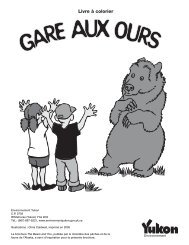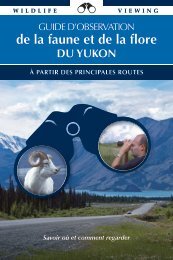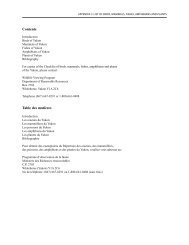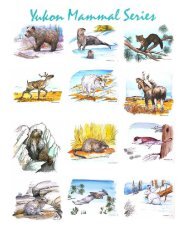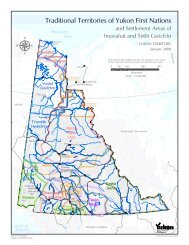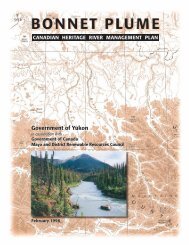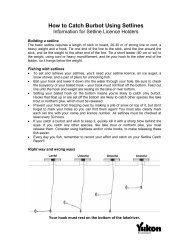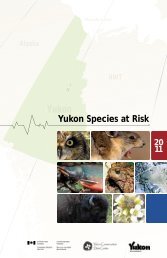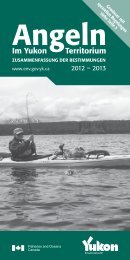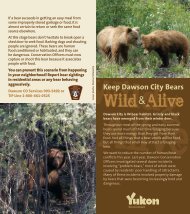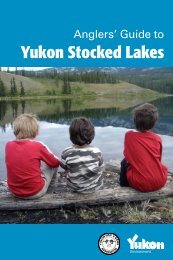Ch. 3 Land - Environment Yukon
Ch. 3 Land - Environment Yukon
Ch. 3 Land - Environment Yukon
Create successful ePaper yourself
Turn your PDF publications into a flip-book with our unique Google optimized e-Paper software.
still exist along the old trails and rivers<br />
in the dry <strong>Yukon</strong> interior. Regenerating<br />
forests in the major river valleys are<br />
evidence of the extensive woodcutting<br />
required to fuel the paddlewheelers.<br />
The City of Whitehorse, at the end of<br />
the rail line, became the major centre<br />
of the territory.<br />
The modern road transportation<br />
network in the <strong>Yukon</strong> really began in<br />
1942 with the construction of the<br />
Alaska Highway. Prior to that time,<br />
there was a winter road from Whitehorse<br />
to Dawson City, a road from<br />
Mendenhall to Silver City on Kluane<br />
Lake, and roads connecting the gold<br />
fields in the Klondike and the mining<br />
operations at Whitehorse and Keno.<br />
Incentives such as the <strong>Yukon</strong> Regional<br />
Resource Road Program (RRRP) and<br />
Resource Transportation Access<br />
Program (RTAP) available from 1986<br />
to 1992, and the federal government’s<br />
Northern Road Policy in effect for 20<br />
years before that increased the number<br />
of roads and trails into the hinterland 1.<br />
Highways link most regions of the<br />
territory and join the <strong>Yukon</strong> to Alaska,<br />
British Columbia and the Northwest<br />
Territories. Old Crow is the only <strong>Yukon</strong><br />
community not accessed by a year<br />
round road.<br />
New roads and trails which exceed the<br />
thresholds of 1.5 meters wide and two<br />
hectares in area require a land use permit<br />
and are subject to environmental<br />
impact assessment. Applications for 51<br />
new logging, mining and access roads<br />
on federal lands were approved<br />
between 1995 and 1999. Another 24<br />
“Any road in the <strong>Yukon</strong> follows<br />
Indian trails, all the way through.<br />
Moose, they have trails, like we<br />
have trails, and they follow the<br />
trails”.<br />
–Paddy Jim, <strong>Ch</strong>ampagne/Aishihik<br />
First Nation Elder 1999<br />
applications to upgrade and use existing<br />
winter roads were also approved 2.<br />
The use of existing mining access and<br />
forest roads for recreation is probably<br />
increasing, associated with the greater<br />
numbers of people taking advantage of<br />
outdoor recreational opportunities in<br />
the <strong>Yukon</strong> backcountry in both summer<br />
and winter.<br />
There is also an increase in air travel<br />
between <strong>Yukon</strong> communities. Flight-<br />
seeing has increased dramatically in the<br />
1990s especially in the Kluane area. Flyin<br />
wilderness operations are expected to<br />
increase as the <strong>Yukon</strong> becomes recognized<br />
as a destination tourist area 3.<br />
The Relationship of Transportation<br />
to the <strong>Environment</strong><br />
The development of a transportation<br />
network results in changes to the land,<br />
its resources and the people living on<br />
the land.<br />
Mineral exploration road west of Nahanni Range Road in the Logan Mountains<br />
C H A P T E R 3 L A N D ❧ 6 5





